What happens when a great writer sits down and starts to reflect on the art and craft of writing? Simple: they leave behind a totem for the rest of us, a message in a bottle to anyone who is looking to do creative work.
These books are the type of books that many of today’s writers turn to for inspiration, illumination—or just a good old fashioned kick in the ass. As part of Writing Routines, we asked a series of famous writers about the books that helped them think about their work, the ones that reflected on the writing and creative process in such a unique or poignant way that they make a pilgrimage to them annually.
For some, it’s a practical book–one that talks about subjects and objects and verbs and the right sequencing of sentences or position of paragraphs. Even seasoned writers find that they benefit from revisiting the basics from time to time. For others, it’s a book about inspiration, about the creative spark, about that elusive thing in your head that takes the firing of neurons and turns them into words on the page. Still for others, it’s a book about the fight of creativity: the struggle that a writer faces every day they sit down to do their work.
What books about the writing process most inspire the world’s great writers? Here are seven that writers we spoke to cannot live without—and quotes that might give you the same feeling they get when they read them:
There’s a reason this book occupies a place of privilege on the shelves of so many writers: it’s just a damn good look at the writing life, broadly defined.
The authors we talked to recommended this book more than any other. It’s a favorite of the bestselling author (and creator of the world’s largest MOOC) Barbara Oakley. Bestselling authors Ryan Holiday and Jeff Goins have also both singled this book out for mention and it’s because Lamott seems to say, on every page, something all of us have thought.
Publishing giant Tim Ferriss even goes as far as recommending Bird by Bird to anyone–writer or not: “If you plan on any creative undertaking, whether business, writing, or art, I strongly recommend the book…If you spend a lot of time working alone and get trapped in your head, it’s required reading. It saved my sanity and has done the same for several friends who’ve gone from ‘I want to quit’ to New York Times bestsellers.” For anyone who needs a good pat on the shoulder as they are making their way through a manuscript or putting the finishing touches on a poem, Lamott is there for you.
Lamott in her own words:
“For some of us, books are as important as almost anything else on earth. What a miracle it is that out of these small, flat, rigid squares of paper unfolds world after world after world, worlds that sing to you, comfort and quiet or excite you. Books help us understand who we are and how we are to behave. They show us what community and friendship mean; they show us how to live and die.”
“Perfectionism is the voice of the oppressor, the enemy of the people. It will keep you cramped and insane your whole life, and it is the main obstacle between you and a shitty first draft. I think perfectionism is based on the obsessive belief that if you run carefully enough, hitting each stepping-stone just right, you won’t have to die. The truth is that you will die anyway and that a lot of people who aren’t even looking at their feet are going to do a whole lot better than you, and have a lot more fun while they’re doing it.”
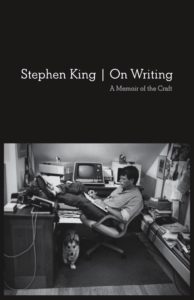
There’s some good instructional info in King’s book, but the real gems are personal: they are the stories of discipline and craft that made King the mega-best-seller that he is. Friendly, funny, and sharp-eyed, this is the kind of book that leaves its reader dog-earing every page. On Writing is a favorite of Deep Work author Cal Newport, Barking Up the Wrong Tree author Eric Barker, and The Daily Beast Editor-in-Chief John Avlon—and the fact that it has fans as diverse as academics and daily journalists goes to show how powerfully it has impacted its audience.
King in his own words:
“Writing isn’t about making money, getting famous, getting dates, getting laid, or making friends. In the end, it’s about enriching the lives of those who will read your work, and enriching your own life, as well. It’s about getting up, getting well, and getting over. Getting happy, okay? Getting happy.”
“Amateurs sit and wait for inspiration, the rest of us just get up and go to work.”
“You can, you should, and if you’re brave enough to start, you will.”
“The scariest moment is always just before you start.”
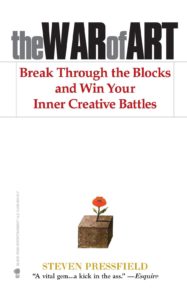
Two connoisseurs of these kinds of books—Ryan Holiday and Jeff Goins—chose The War of Art by Steven Pressfield as an inspiring addition to their collection of books on creativity and the written word. And with good reason. Pressfield is refreshingly unsentimental about what it takes to get work done. He even gives the enemy of creative work a name: The Resistance. Though the devil takes different forms to different people, anyone who has written anything (and struggled with it) will identify completely with Pressfield’s account of a powerful force whose only job in the universe is to stop you from doing your work. Lucky for all of us, he gives us tactics to banish that demon too.
Pressfield in his own words:
“If you find yourself asking yourself (and your friends), “Am I really a writer? Am I really an artist?” chances are you are. The counterfeit innovator is wildly self-confident. The real one is scared to death.”
“This is the other secret that real artists know and wannabe writers don’t. When we sit down each day and do our work, power concentrates around us. The Muse takes note of our dedication. She approves. We have earned favor in her sight. When we sit down and work, we become like a magnetized rod that attracts iron filings. Ideas come. Insights accrete.”
“We must do our work for its own sake, not for fortune or attention or applause.”
“The most important thing about art is to work. Nothing else matters except sitting down every day and trying.”
Resistance is experienced as fear; the degree of fear equates to the strength of Resistance. Therefore the more fear we feel about a specific enterprise, the more certain we can be that that enterprise is important to us and to the growth of our soul. That’s why we feel so much Resistance. If it meant nothing to us, there’d be no Resistance.”
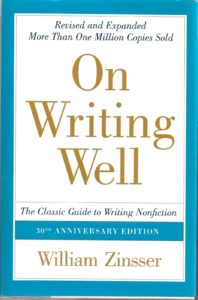
It’s a book that has stood the test of time, sold over a million-and-a-half copies, and is probably the book that all of us start reading when we enter into the “good books about writing” genre. Zinnser’s book is empathetic, generous, and plain-spoken—much like the writer who put it together. He distilled his decades of writing and editing experience into truths that should be re-read every year because of how important they are.
Zinsser in his own words:
“Decide what you want to do. Then decide to do it. Then do it.”
“Examine every word you put on paper. You’ll find a surprising number that don’t serve any purpose.”
“Clutter is the disease of American writing. We are a society strangling in unnecessary words, circular constructions, pompous frills and meaningless jargon.”
“Ultimately, the product any writer has to sell is not the subject being written about, but who he or she is…“I often find myself reading with interest about a topic I never thought would interest me — some scientific quest, perhaps. What holds me is the enthusiasm of the writer for his field.”
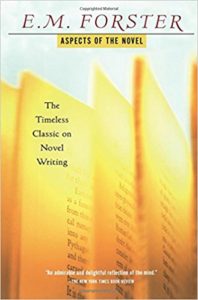
When TJ Stiles—ace historian whose histories are as good as novels—and Aaron Thier—one of his generation’s up-and-coming novelists—single out a book for mention, you know it’s worth looking at. Forster dissects the novel like a surgeon, and in doing so, reveals the things that make all stories engaging and interesting. Originally delivered as lectures, Forster dives into story, people, plot, fantasy, prophecy, pattern, and rhythm. It’s an easier read than you might think given Forster’s background and work, and generations of readers seem to agree that it gives them insight into their work—and the work of writers they love.
Forster in his own words:
“Long books, when read, are usually overpraised, because the reader wishes to convince others and himself that he has not wasted his time.”
“Expansion. That is the idea the novelist must cling to. Not completion. Not rounding off, but opening out.”
“Let us think of people as starting life with an experience they forget and ending it with one which they anticipate but cannot understand.”
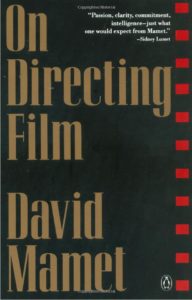
Mamet is a jack of all writing trades: a screenwriter, playwright, essayist, and director. He’s done it all, and lived to tell about it. And this book distilling much of his knowledge about film is brilliant. Even for people who work on the page, Mamet’s advice about thinking visually is important–and well worth diving into. As Eric Barker put it, “David Mamet’s little book about directing turns out to be one of the best books on writing.”
Mamet in his own words:
My experience as a director, and as a dramatist, is this: the piece is moving in proportion to how much the author can leave out. A good writer gets better by learning to remove the ornamental, the descriptive… What remains? The story remains. What is the story? The story is the essential progression of incidents that occur to the hero in pursuit of her one goal.
How do we keep the audience’s attention? Certainly not by giving them more information but, on the contrary, by withholding information—by withholding all information except that information in the absence of which would make the progress of the story incomprehensible.
The making of a story… consists of the assiduous application of several very basic questions: What does the hero want? What hinders him from getting it? What happens if he does not get it? That’s what keeps the audience in their seats… The story can only be interesting because we find the progress of the protagonist interesting. As long as the protagonist wants something, the audience will want something.
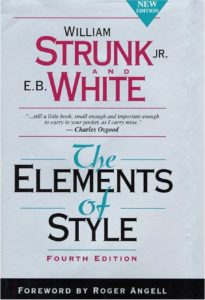
Zinsser admitted that his own work On Writing Well owed a debt to The Elements of Style. But then he’s not the only one. It’s a book you’ll find on basically any serious writer’s shelf, and while decades have passed since it was first published in 1918, few books have matched its impact since. The poet Dorothy Parker once said, “If you have any young friends who aspire to become writers, the second-greatest favor you can do them is to present them with copies of The Elements of Style. The first-greatest, of course, is to shoot them now, while they’re happy.”
Take her advice for what you will–but it’s the rare book that manages to stand the test of time the way The Elements of Style has.
From Strunk and White themselves:
“To achieve style, begin by affecting none.”
“The mind travels faster than the pen; consequently, writing becomes a question of learning to make occasional wing shots, bringing down the bird of thought as it flashes by. A writer is a gunner, sometimes waiting in the blind for something to come in, sometimes roaming the countryside hoping to scare something up.”
“Vigorous writing is concise. A sentence should contain no unnecessary words, a paragraph no unnecessary sentences, for the same reason that a drawing should have no unnecessary lines and a machine no unnecessary parts. This requires not that the writer make all his sentences short, or that he avoid all detail and treat his subjects only in outline, but that every word tell.”
Sign up to get a brand new writing routine in your inbox every week.
